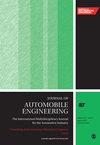烤箱老化轮胎的耐久性评估和模拟
IF 1.5
4区 工程技术
Q3 ENGINEERING, MECHANICAL
Proceedings of the Institution of Mechanical Engineers Part D-Journal of Automobile Engineering
Pub Date : 2024-04-18
DOI:10.1177/09544070241242895
引用次数: 0
摘要
轮胎耐久性一直是乘客和车辆安全的重要组成部分,通常需要多年的道路服务来测试相关性能。轮胎烘箱老化试验已被广泛接受为一种加速实验室试验,可在高温下诱导橡胶化合物发生大量热氧化,并产生机械降解。然后,在滚筒上对经过烘箱老化的轮胎进行测试,以比较耐久时间和故障位置。轮胎是由不同结构和配方的各种部件组装而成的,因此轮胎老化和耐久性测试是一个复杂的问题,其中包括氧气渗透、消耗和机械降解。因此,需要一个预测性的工作流程和模型来评估烤箱老化程度和相应的耐久性能。本文以计算出的轮胎局部耗氧量为基础,通过建立复合耗氧量与退化机械性能之间的定量相关性,为轮胎有限元分析模型中的每个元素分配老化性能。随后,利用 SEDG(应变能量密度梯度)进行了轮胎力学模拟,以评估和比较不同内衬结构和配方的烤箱老化轮胎的耐久性。本文章由计算机程序翻译,如有差异,请以英文原文为准。
Durability evaluation and simulation of oven aged tires
Tire durability has been an essential part of passenger and vehicle safety, which usually requires years of road services to test relevant performance. The tire oven aging test has been widely accepted as an accelerated laboratory test to induce large thermal oxidation of rubber compounds with mechanical degradations under high temperatures. Then, the oven-aged tires are tested on rolling drums to compare the durability hours and failure locations. As an assembly of various components with different structures and formulations, tire aging and durability tests are complicated issues incorporating oxygen permeation, consumption, and mechanical degradation. Therefore, it calls for a predictive workflow and model to evaluate the oven aging extent and corresponding durability performance. Based on the computed local oxygen consumption of tires, this article assigns the aged property to each element in a tire FEA (Finite Element Analysis) model by building the quantitative correlations between compound oxygen consumption and degraded mechanical properties. Subsequently, tire mechanics simulations are conducted with SEDG (Strain Energy Density Gradient) to evaluate and compare the endurance of oven-aged tires with different inner liner structures and formulations.
求助全文
通过发布文献求助,成功后即可免费获取论文全文。
去求助
来源期刊

CiteScore
4.40
自引率
17.60%
发文量
263
审稿时长
3.5 months
期刊介绍:
The Journal of Automobile Engineering is an established, high quality multi-disciplinary journal which publishes the very best peer-reviewed science and engineering in the field.
 求助内容:
求助内容: 应助结果提醒方式:
应助结果提醒方式:


